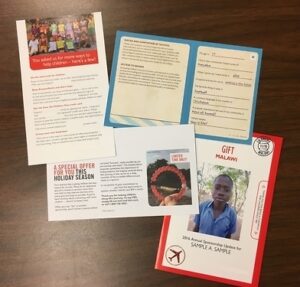
Have you ever donated to charity and received a message in return that says something like, “Thank you. Your donation is very much appreciated.” Blah, it makes me cringe. You can tell it’s the same letter sent to all donors and it certainly doesn’t make you feel like your gift is fully appreciated. How do you know how your money is being put to use? Are you really helping someone or is it a scam? You probably won’t feel as motivated to donate again after this. But when I get a postcard from St. Jude that says, “Dear Michael, your recent $5 donation helped put Caitlin through another round of chemotherapy. Will you do the same for another sick child?” I find it hard not to send another gift. The card even had a smiling picture of Caitlin. The personalized content in that letter is accomplished through variable data printing, which is something all non-profit organizations should practice.
Non-profits have a different marketing task than most industries. Instead of selling a product, they need to convince people to help others through a monetary donation or volunteering. It’s challenging because they have to establish a cause, appeal to an emotion, and build a trusting relationship. How can this relationship be created with total strangers? The answer is simple: don’t treat them like strangers.
Although donations can now be made online easily, non-profits should still use direct mail more than anyone else. In 2010, 61% of surveyed donors said they gave through direct mail at least once. Even if people donate online, they are likely prompted to do so through a direct mail piece. 37% of online donors said they did so because they received a piece of direct mail, looked it up, and donated through the website. And consistently mailing to the same people, especially past donors, makes them more likely to donate again. Or if you want to make it even easier, put a QR code on the letter that links to the donation page.
When you’re marketing to someone who you hope will join your cause, you need to form a special bond. Sending a direct mail piece addressed to “current resident” doesn’t do that. If you use variable data printing, each letter will be tailored to its specific recipient to add a personal touch. Statistics from 2017 show that adding a person’s name, full color, and sophisticated database information to the piece can increase response rates up to 500%. But variable data doesn’t have to be just the person’s name. You can vary data by donation history, imagery, motive, and more. Capturing their attention this way prompts them to read the piece longer and allows you to explain your cause more deeply.
 NextPage has a non-profit client that helps children living in poverty. They serve in 22 countries and have over 71,000 donor records. We produced a direct mail campaign for them that varied data based on the child(ren) and country the donor supported. The piece personalized information with a picture of the child, how long the donor has supported that child, and how their generous help has impacted the country. This strategy increased their sponsorship rates by at least 5% every year.
NextPage has a non-profit client that helps children living in poverty. They serve in 22 countries and have over 71,000 donor records. We produced a direct mail campaign for them that varied data based on the child(ren) and country the donor supported. The piece personalized information with a picture of the child, how long the donor has supported that child, and how their generous help has impacted the country. This strategy increased their sponsorship rates by at least 5% every year.
You can expect better retention rates with an improved connection. When you use VDP, you show your target audience that you’ve done your research and remember the contribution that your donors made to change the world.
Learn more about successful direct mail campaigns by downloading our free eBook, “The NextPage Guide to Direct Mail Success.”
